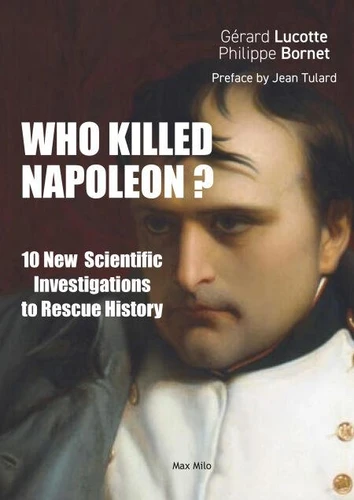Who killed Napoleon?. 10 new scientific investigations to rescue history
Par : ,Formats :
Disponible dans votre compte client Decitre ou Furet du Nord dès validation de votre commande. Le format ePub protégé est :
- Compatible avec une lecture sur My Vivlio (smartphone, tablette, ordinateur)
- Compatible avec une lecture sur liseuses Vivlio
- Pour les liseuses autres que Vivlio, vous devez utiliser le logiciel Adobe Digital Edition. Non compatible avec la lecture sur les liseuses Kindle, Remarkable et Sony
- Non compatible avec un achat hors France métropolitaine
 , qui est-ce ?
, qui est-ce ?Notre partenaire de plateforme de lecture numérique où vous retrouverez l'ensemble de vos ebooks gratuitement
Pour en savoir plus sur nos ebooks, consultez notre aide en ligne ici
- Nombre de pages184
- FormatePub
- ISBN978-2-315-02171-0
- EAN9782315021710
- Date de parution04/11/2024
- Protection num.Adobe DRM
- Taille6 Mo
- Infos supplémentairesepub
- ÉditeurMax Milo
- PréfacierJean Tulard
Résumé
"Let the muse of history be silent, and make way for genetics." Jean Tulard
"Fascinating." Jean-Noël Fabiani, Professor Emeritus, Chair of the History of Medicine
Until recent years, many mysteries and rumors have surrounded Napoleon. Was Napoleon's body taken by the British and placed in Westminster Abbey? Was he poisoned with arsenic? Did he die of hereditary stomach cancer, as the English claimed, or of hepatitis and dysentery rampant on that unhealthy island? Was Napoleon III descended from the Emperor? Did the Emperor's physician remove Napoleon's penis after his death on St.
Helena in 1821? To answer these and many other questions, Professor Gérard Lucotte spent twelve years working on this subject. He was commissioned by Prince Charles Napoléon (a descendant of the Emperor, through the branch descended from Jérôme Bonaparte, the Emperor's youngest brother) and Count Walewski (a descendant of Napoleon the First's natural son) to work on Napoléon's DNA. Thanks to his genetics laboratory and electron microscope, he has achieved a gigantic feat that will astound all Napoleon enthusiasts.
Helena in 1821? To answer these and many other questions, Professor Gérard Lucotte spent twelve years working on this subject. He was commissioned by Prince Charles Napoléon (a descendant of the Emperor, through the branch descended from Jérôme Bonaparte, the Emperor's youngest brother) and Count Walewski (a descendant of Napoleon the First's natural son) to work on Napoléon's DNA. Thanks to his genetics laboratory and electron microscope, he has achieved a gigantic feat that will astound all Napoleon enthusiasts.
"Let the muse of history be silent, and make way for genetics." Jean Tulard
"Fascinating." Jean-Noël Fabiani, Professor Emeritus, Chair of the History of Medicine
Until recent years, many mysteries and rumors have surrounded Napoleon. Was Napoleon's body taken by the British and placed in Westminster Abbey? Was he poisoned with arsenic? Did he die of hereditary stomach cancer, as the English claimed, or of hepatitis and dysentery rampant on that unhealthy island? Was Napoleon III descended from the Emperor? Did the Emperor's physician remove Napoleon's penis after his death on St.
Helena in 1821? To answer these and many other questions, Professor Gérard Lucotte spent twelve years working on this subject. He was commissioned by Prince Charles Napoléon (a descendant of the Emperor, through the branch descended from Jérôme Bonaparte, the Emperor's youngest brother) and Count Walewski (a descendant of Napoleon the First's natural son) to work on Napoléon's DNA. Thanks to his genetics laboratory and electron microscope, he has achieved a gigantic feat that will astound all Napoleon enthusiasts.
Helena in 1821? To answer these and many other questions, Professor Gérard Lucotte spent twelve years working on this subject. He was commissioned by Prince Charles Napoléon (a descendant of the Emperor, through the branch descended from Jérôme Bonaparte, the Emperor's youngest brother) and Count Walewski (a descendant of Napoleon the First's natural son) to work on Napoléon's DNA. Thanks to his genetics laboratory and electron microscope, he has achieved a gigantic feat that will astound all Napoleon enthusiasts.






